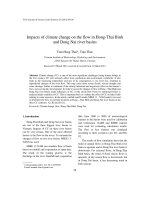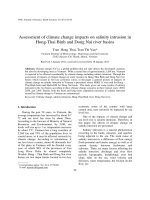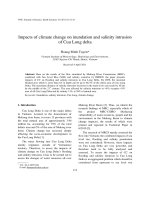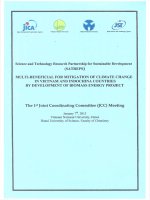ompacts of climate change on allegens and allegic disseases
Bạn đang xem bản rút gọn của tài liệu. Xem và tải ngay bản đầy đủ của tài liệu tại đây (20.37 MB, 227 trang )
Free ebooks ==> www.Ebook777.com
www.Ebook777.com
Free ebooks ==> www.Ebook777.com
IMPAC T S O F C L IMATE CHANGE ON
AL L E R G E N S A N D A L LERGI C DI SEASES
Climate change has been identified as the biggest global health threat of the
twenty-first century (The Lancet). Hundreds of millions of people around the
world currently suffer from allergic diseases such as asthma and allergic rhinitis
(hay fever), and the prevalence of these diseases is increasing. This book is the
first authoritative and comprehensive assessment of the many impacts of climate
change on allergens, such as pollen and mould spores, and allergic diseases. The
international authorship team of leaders in this field explore the topic to a breadth
and depth far beyond any previous work. This book will be of value to anyone
with an interest in climate change, environmental allergens, and related allergic
diseases. It is written at a level that is accessible for those working in related
physical, biological, and health and medical sciences, including researchers, academics, clinicians, and advanced students.
is Professor in the Department of Environmental Sciences at
Macquarie University, Australia. In 2009 he was awarded the Eureka Prize for
Medical Research for his research on the impacts of climate change on allergens
and allergic diseases. He was a contributing author of the Fourth Assessment
Report of the Intergovernmental Panel on Climate Change, published in 2007, the
same year the Intergovernmental Panel on Climate Change won the Nobel Peace
Prize. He was the President of the International Society of Biometeorology from
2008 to 2011.
PAUL J. BEGGS
www.Ebook777.com
IMPAC T S OF C L I M AT E C H A N G E
ON AL L E R G E N S A N D
AL L E R GI C D IS E A S E S
Edited by
PAUL J. B E GGS
Macquarie University
Free ebooks ==> www.Ebook777.com
University Printing House, Cambridge CB2 8BS, United Kingdom
Cambridge University Press is part of the University of Cambridge.
It furthers the University’s mission by disseminating knowledge in the pursuit of
education, learning and research at the highest international levels of excellence.
www.cambridge.org
Information on this title: www.cambridge.org/9781107048935
© Cambridge University Press 2016
This publication is in copyright. Subject to statutory exception
and to the provisions of relevant collective licensing agreements,
no reproduction of any part may take place without the written
permission of Cambridge University Press.
First published 2016
Printed in the United States of America by Sheridan Books, Inc.
A catalogue record for this publication is available from the British Library.
Library of Congress Cataloguing in Publication Data
Names: Beggs, Paul J., 1968 – editor.
Title: Impacts of climate change on allergens and allergic diseases /
Paul J. Beggs, editor, Department of Environmental Sciences, Faculty of
Science and Engineering, Macquarie University.
Description: Cambridge : Cambridge University Press, 2016. |
Includes bibliographical references and index.
Identifiers: LCCN 2016017601 | ISBN 9781107048935 (hardback)
Subjects: LCSH: Climatic changes – Health aspects. | Environmental
health. | Allergens. | Respiratory allergy.
Classification: LCC QC903.I448 2016 | DDC 614.5/993–dc23
LC record available at />ISBN 978-1-107-04893-5 Hardback
Cambridge University Press has no responsibility for the persistence or accuracy of
URLs for external or third-party internet websites referred to in this publication,
and does not guarantee that any content on such websites is, or will remain,
accurate or appropriate.
www.Ebook777.com
This book is dedicated to Dr. Diana J. Bass, who in the early
1990s generously introduced me to the wonderful world
of airborne pollen and mould spore monitoring and, in so
doing, set me on the path that would ultimately lead to the
production of this book.
There are likely to be quantitative and/or qualitative changes in the airborne
concentration of allergens, e.g., molds and pollens. This in turn could lead
to changes in the prevalence or intensity of asthma and hay fever episodes
in affected individuals.
(Janice Longstreth, “Anticipated public health
consequences of global climate change”)
Contents
List of Figures
List of Tables
List of Contributors
Preface
Acknowledgements
List of Acronyms and Abbreviations
page ix
xi
xiii
xvii
xix
xxi
1Introduction
1
PAUL J. BEGGS
2
Impacts of Climate Change on Aeroallergen Production and
Atmospheric Concentration
10
ANNETTE MENZEL AND SUSANNE JOCHNER
3
Impacts of Climate Change on the Distributions of Allergenic Species
29
LINDA J. BEAUMONT AND DAISY E. DUURSMA
4
Impacts of Climate Change on Aeroallergen Dispersion,
Transport, and Deposition
50
MIKHAIL SOFIEV AND MARJE PRANK
5
Impacts of Climate Change on Allergenicity
74
JEROEN T. M. BUTERS
6
Impacts of Climate Change on Allergen Seasonality
92
LEWIS H. ZISKA
7
Impacts of Climate Change on Indoor Allergens
113
GINGER L. CHEW AND SHUBHAYU SAHA
vii
viii
Contents
8 Interactions among Climate Change, Air Pollutants, and Aeroallergens 137
PATRICK L. KINNEY, KATE R. WEINBERGER, AND RACHEL L. MILLER
9 Impacts of Climate Change on Allergic Diseases
157
CONSTANCE H. KATELARIS
10 Synthesis and Conclusion
179
PAUL J. BEGGS AND LEWIS H. ZISKA
Index
Colour plates are to be found between pages 136 and 137.
189
Free ebooks ==> www.Ebook777.com
Figures
1.1
3.1
4.1
4.2
4.3
4.4
4.5
4.6
4.7
4.8
5.1
5.2
5.3
5.4
6.1
7.1
7.2
7.3
7.4
Monthly mean atmospheric carbon dioxide concentration at Mauna Loa
Observatory from March 1958 to July 2015
Diagrammatic representation of a correlative species distribution model
A schematic view of the main parts of pollen life cycle in the atmosphere
Wind speed at 10 m in (a) April and (b) August for the years 1980–2013
for three European regions: south (6°W, 38°N –3°W, 41°N), central
(10°E, 49°N –13°E, 52°N), north (22°E, 61°N –25°E, 64°N)
Wind direction at 10 m (ϕ10) in April for the years 1980–2013 (a), and
u10–v10 scatter plots for wind at 10 m (b)
Turbulent intensity (Kz) at 1 m in (a) April and (b) August for the years
1980–2013
Relative humidity at 2 m in (a) April and (b) August for the years
1980–2013
Total monthly rain duration in (a) April and (b) August for the
years 1980–2013
Birch total seasonal pollen count in Europe for 2000 and its
1980–2012 trend
Grass total seasonal pollen count in Europe for 2000 and its
1980–2012 trend
Shape of Dactylis glomerata pollen at ambient humidity
Allergenicity of olive pollen from different climatic areas
Pollen potency depending on climatic conditions
Allergen Bet v 1 expression in birch pollen upon ripening from four
trees in Munich during April 2007
Changes in ragweed pollen seasonality as a function of urbanisation
along a rural–urban transect for Baltimore, Maryland, USA
An explanation for why carpet serves as a reservoir for dust mites
New Orleans building after flooding from Hurricane Katrina
Trends in the percentage of homes with air-conditioning across the
United States from 1980 to 2009
Heat pumps for air-conditioning in summer and heating during winter
are widely used in Beijing, China
page 4
36
51
56
58
60
62
63
67
68
77
78
80
82
102
119
121
124
125
ix
www.Ebook777.com
x
7.5
7.6
7.7
Figures
Flooded basements are difficult to dry quickly
US map representing percentage of housing units in each county in
100-year flood hazard areas
County-level estimates of percentage of housing units in 100-year flood
hazard areas for six metropolitan statistical areas –Atlanta, Baltimore,
Boston, Memphis, northern New Jersey, and New York
126
128
129
Tables
6.1
6.2
7.1
7.2
Changes in initiation (start) dates (as day of the year) for pollen
release for known allergenic species of trees in response to recent
warming trends
Changes in initiation (start) dates (as day of the year) for pollen
release for known allergenic species of weeds and grasses in
response to recent warming trends
Dust mite, cockroach, and mouse allergic sensitisation
Percentage of single-unit houses with basement (full or partial) built
within the four years prior to the American Housing Survey for each
of the six metropolitan statistical areas
page 95
97
116
127
xi
Contributors
Linda J. Beaumont, PhD
Department of Biological Sciences
Faculty of Science and Engineering
Macquarie University
New South Wales 2109
Australia
Paul J. Beggs, PhD
Department of Environmental Sciences
Faculty of Science and Engineering
Macquarie University
New South Wales 2109
Australia
Jeroen T. M. Buters, PhD
Center of Allergy and Environment (ZAUM)
Technical University Munich and Helmholtz Center Munich
Biedersteiner Strasse 29
80802 Munich
Germany
and
Christine Kühne Center for Allergy Research and Education
Davos
Switzerland
Ginger L. Chew, ScD
Centers for Disease Control and Prevention
National Center for Environmental Health
Division of Environmental Hazards and Health Effects
xiii
xiv
Contributors
Air Pollution and Respiratory Health Branch
4770 Buford Hwy., N.E., MS-F60
Atlanta, GA 30341
United States of America
Daisy E. Duursma, MSc
Department of Biological Sciences
Faculty of Science and Engineering
Macquarie University
New South Wales 2109
Australia
Susanne Jochner, PhD
Physical Geography / Landscape Ecology and
Sustainable Ecosystem Development
Catholic University of Eichstätt-Ingolstadt
Ostenstraße 18
85072 Eichstätt
Germany
Constance H. Katelaris, PhD, MBBS
School of Medicine
Western Sydney University
Campbelltown 2560
New South Wales
Australia
and
Immunology and Allergy
Department of Medicine
Campbelltown Hospital
Campbelltown 2560
New South Wales
Australia
Patrick L. Kinney, ScD
Climate and Health Program
Mailman School of Public Health
Columbia University
722 West 168th Street
New York, NY 10032
United States of America
Contributors
Annette Menzel, PhD
Ecoclimatology
Technische Universität München
Hans-Carl-von-Carlowitz-Platz 2
85354 Freising
Germany
Rachel L. Miller, MD
Division of Pulmonary, Allergy, and Critical Care Medicine
Columbia University Medical Center
PH8E-101B, 630 W.
168th Street
New York, NY 10032
United States of America
Marje Prank, MSc
Finnish Meteorological Institute
Erik Palménin aukio 1
FI-00560 Helsinki
Finland
Shubhayu Saha, PhD
Centers for Disease Control and Prevention
National Center for Environmental Health
Division of Environmental Hazards and Health Effects
Air Pollution and Respiratory Health Branch
4770 Buford Hwy., N.E., MS-F60
Atlanta, GA 30341
United States of America
Mikhail Sofiev, PhD
Finnish Meteorological Institute
Air Quality Research
Erik Palménin aukio 1
FI-00560 Helsinki
Finland
Kate R. Weinberger, PhD
Institute at Brown for Environment & Society
Brown University
Box 1951
xv
xvi
85 Waterman Street
Providence, RI 02912
United States of America
Lewis H. Ziska, PhD
Crop Systems and Global Change
Agricultural Research Service
US Department of Agriculture
10300 Baltimore Avenue
Beltsville, MD 20705
United States of America
Contributors
Preface
This book considers the impacts of climate change on allergens and allergic
diseases. It is the first book to focus on this topic. It provides a comprehensive and
up-to-date review, assessment, and synthesis of this topic based on the scientific
literature. In addition, two of the chapters (Chapters 4 and 7) also present new
findings.
Warming of the climate system is unequivocal, and the concentrations of greenhouse gases such as carbon dioxide have increased. These and many other conclusions by the Intergovernmental Panel on Climate Change’s Working Group I in its
contribution to the Fifth Assessment Report published in 2013 provide the climate
change context for this book. The introductory chapter (Chapter 1) provides a brief
description of this, focusing on aspects of climate change most relevant to allergens and allergic diseases.
The book considers both observed (past and current) and projected (future)
impacts. The spatial scope of the book is global and international. However, the
nature of this topic requires that the full range of scales be considered, from the
micro and molecular to the macro.
The book consists of ten chapters. Seven of these (Chapters 2 to 8) focus primarily on the impacts of climate change on allergens per se. Each of these chapters
explores a different aspect: aeroallergen production and atmospheric concentration (Chapter 2); the distributions of allergenic species (Chapter 3); aeroallergen
dispersion, transport, and deposition (Chapter 4); allergenicity (Chapter 5); allergen seasonality (Chapter 6); indoor allergens (Chapter 7); and interactions among
air pollutants and aeroallergens (Chapter 8). Chapter 9 explores climate change
impacts on allergic diseases explicitly. A synthesis of the preceding nine chapters
and an overview of mitigation and adaptation responses in the context of climate
change impacts on allergens and allergic diseases are presented in Chapter 10. This
final chapter also highlights a range of knowledge gaps and research needs. An
xvii
xviii
Preface
impressive list of allergen-producing organisms, allergens, and allergic diseases
is discussed. The former include a wide range of plants (trees, shrubs and weeds,
and grasses), fungi, cockroaches, house dust mites, mice, and stinging insects. The
allergic diseases considered here range from asthma and allergic rhinitis to allergic
rhinoconjunctivitis, atopic dermatitis, insect sting allergy, and food allergy. Much
of the focus, however, is on plants and the pollen they produce, and asthma and
allergic rhinitis.
The chapters of this book have been contributed by fifteen authors in all. The
lead authors of Chapters 2 to 9 are internationally acclaimed experts and have been
specially invited to write on their respective subjects. Most of the lead authors have
preferred to take on one or more of their colleagues as co-authors. The authorship
team has represented both the Northern and Southern Hemispheres, three geographical regions (Europe, Northern America, and Oceania), and four countries
(Australia, Finland, Germany, and the USA). They also represent a range of institutions, including universities, a national disease control and prevention centre,
hospitals and medical centres, a national meteorological institute, and a national
agricultural research service. Each of the authors has approached the given subject
from their own disciplinary perspective: ecology, environmental health sciences,
allergy and immunology, meteorology, botany, and so on. However, the experience
and expertise of each of the authors transcends any one discipline; they are all
truly and necessarily interdisciplinary. The introductory and concluding chapters
(Chapters 1 and 10) have been written by the book’s editor, with Chapter 10 being
co-authored by the lead author of Chapter 6.
The text of the book is complemented with tables and figures where appropriate, and cross-referencing between chapters enhances integration and minimises
duplication. However, different aspects of a topic cannot be properly considered
in total isolation and so some overlap is necessary and desirable. Finally, a broad
range of acronyms and abbreviations are used in the book, and a consolidated list
is provided in this front matter.
Ultimately, this book presents an authoritative picture of what we know about
the impacts of climate change on allergens and allergic diseases, and a call for
action –appropriate responses to what we know, and more research to fill the gaps
in our knowledge.
Free ebooks ==> www.Ebook777.com
Acknowledgements
I would first like to thank all the authors of this book. Their acceptance of my
invitation to contribute to this book in many respects surprised and overwhelmed
me. Some I had never met and only knew by their reputation, yet they generously
embarked on this long journey with me. While all chapters presented a challenge to
their author(s), some were more challenging because I had requested them to write
on an aspect of this topic that, while important, had received little if any attention
previously. And in two particular cases, the authors’ progress on the writing suffered a setback when they encountered monumental personal hardships, but both
remained loyal and committed to the project and came through with their chapters.
A special thank you also to Dr Matt Lloyd, Publishing Director, Science,
Technology, and Medicine, Americas, at Cambridge University Press. Again, this
book would not have existed without Matt. His visit to Macquarie University at
the end of July 2012, for which he had prearranged a meeting with me to discuss
any book idea I might have, enabled me to pitch the idea to him, and his immediate enthusiasm and encouragement resulted in me getting a book proposal in to
Cambridge University Press just a month later. Matt and I have only met once, but
his guidance and support through this process has been unwavering, even when the
project continued on for much longer than I had thought (although I am sure he
has seen it all before, and hopefully he has had book projects that took longer than
mine!). Beyond Matt taking the initiative to meet with me back in 2012 and his
provision of sage advice at a number of crucial times, I thank him for providing me
with the freedom and flexibility to bring things together as and when I could. I took
on the position as Head, Department of Environmental Sciences at Macquarie, in
January 2013, and as much as I made this book project a priority, the challenges
and demands of this position likely meant some things took longer than they otherwise would have. I really appreciate Matt for not pressuring me during that time.
I also thank the many others at Cambridge University Press who have contributed to the production of this book in one way or another. In particular, I thank
xix
www.Ebook777.com
xx
Acknowledgements
David Morris (Project Manager, Academic Publishing), Cassi Roberts (Content
Assistant, Academic Books), and Zoë Pruce (Content Manager, Academic Books)
for expertly guiding me through the production process. I also acknowledge the
amazing work of Ramesh Karunakaran (Project Manager) and Pradeep Kumar
(Copy Editor) and others at Newgen during the copyediting, typesetting, and
proofing stages.
As part of the process of putting this book together, I had sent chapters to
reviewers for comment and feedback. They too have made a valuable contribution
to the quality of this book, and I thank them for this: Lorenzo Cecchi (Università
degli Studi di Firenze (University of Florence, Italy); Bernard Clot (Federal Office
of Meteorology and Climatology MeteoSwiss, Switzerland); Kris Ebi (University
of Washington, USA); Simon Haberle (The Australian National University,
Australia); and Mark Schwartz (University of Wisconsin-Milwaukee, USA). And
I thank two anonymous reviewers of the original book proposal submitted to
Cambridge University Press.
And finally I wish to acknowledge all those who have mentored, encouraged,
and supported me over the many years of my career, and prior to that. Thank you
to Macquarie University and my many colleagues and friends there. Similarly,
thank you to my colleagues and friends in the wonderful and intriguing worlds of
biometeorology, aerobiology, and environmental health science. What better professional communities could an academic and scholar hope for? And to my partner
Leanne (and our dog Caley), my family, and my friends –thanks is simply not
enough, but thank you anyway.
Acronyms and Abbreviations
AAAAI
American Academy of Allergy, Asthma, and Immunology
ABL
Atmospheric boundary layer
AC
Air-conditioning
AC
Allergic conjunctivitis
AD
Atopic dermatitis
AHS
American Housing Survey
AP
Allergen-producing
API
Annual pollen index
AR
Allergic rhinitis
Aw
Water activity
β2AR
β2 adrenergic receptor
CCCEH
Columbia Center for Children’s Environmental Health
CDC
Centers for Disease Control and Prevention (USA)
CEE
Central and Eastern Europe
cfu
Colony-forming unit
CH4Methane
CI
Confidence interval
CO
Carbon monoxide
CO2
Carbon dioxide
DALYs
Disability-adjusted life years
DC
District of Columbia
DEPs
Diesel exhaust particles
DNADeoxyribonucleic acid
DOY
Day of the year
EAN
European Aeroallergen Network
ECElemental carbon
ECMWF
European Centre for Medium-Range Weather Forecasts
xxi
xxii
Acronyms and Abbreviations
ECRHS
European Community Respiratory Health Survey
ED
Emergency department
EPA
Environmental Protection Agency (USA)
FACE
Free-air CO2 enrichment
FEMA
Federal Emergency Measurement Agency (USA)
FIA
Forest Inventory and Analysis
2
GA LEN
Global Allergy and Asthma Network of Excellence
GCMs
General circulation models
GHGGreenhouse gases
GINA
Global Initiative for Asthma
GIS
Geographic information systems
GMGeometric mean
HDM
House dust mite
HIALINE Health Impacts of Airborne Allergen Information Network
IFN-γInterferon gamma
IgEImmunoglobulin E
IL-4
Interleukin 4
IL-10
Interleukin 10
IPCC
Intergovernmental Panel on Climate Change
ISAAC
International Study of Asthma and Allergies in Childhood
KLH
Keyhole limpet hemocyanin
Kz1
Turbulent diffusion coefficient at 1 m above the ground
LPG
Liquefied petroleum gas
MAS
Multicenter Allergy Study
MSAs
Metropolitan statistical areas
NHANES National Health and Nutrition Examination Survey (USA)
NO2
Nitrogen dioxide
NOAA
National Oceanic and Atmospheric Administration (USA)
NOx
Reactive nitrogen oxides (sum of NO and NO2)
O3Ozone
OCOrganic carbon
OROdds ratio
OVAOvalbumin
PAHs
Polycyclic aromatic hydrocarbons
PAR2
Protease-activated receptor 2
PCR
Polymerase chain reaction
PEFR
Peak expiratory flow rate
PMParticulate matter
PM2.5
Particulate matter with aerodynamic diameter <2.5 μm
newgenprepdf
Acronyms and Abbreviations
PM10
ppb
ppm
PSP
Q2
RCP
RH
SARC
SDM
sIgE
SILAM
SO2
TENOR
Th1
Th2
τpr
u
U10
v
VOCs
WHO
ϕ10
Particulate matter with aerodynamic diameter <10 μm
Parts per billion
Parts per million
Polystyrene particles
Relative humidity at 2 m above the ground
Representative concentration pathway
Relative humidity
Seasonal allergic rhinoconjunctivitis
Species distribution model
Specific immunoglobulin E
System for Integrated modeLing of Atmospheric composition
Sulphur dioxide
The Epidemiology and Natural History of Asthma: Outcomes
and Treatment Regimens
Type 1 T helper cell
Type 2 T helper cell
Fraction of rainy periods per month
Longitudinal wind component
Wind speed at 10 m above the ground
Latitudinal wind component
Volatile organic compounds
World Health Organization
Wind direction at 10 m above the ground
xxiii









